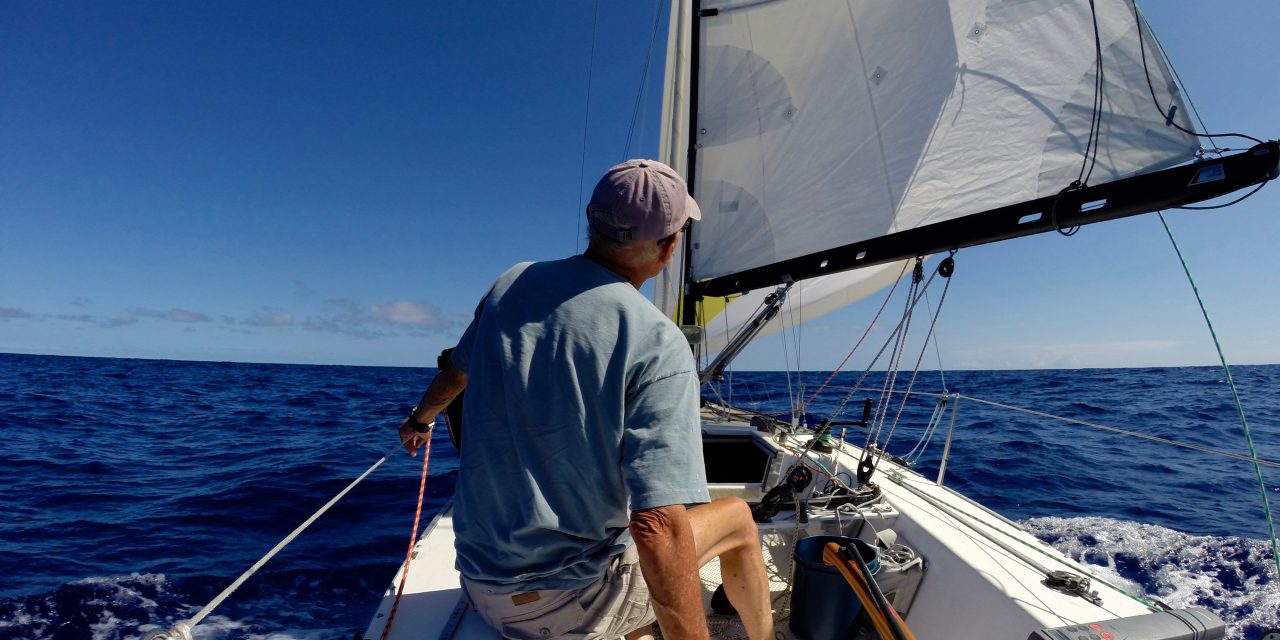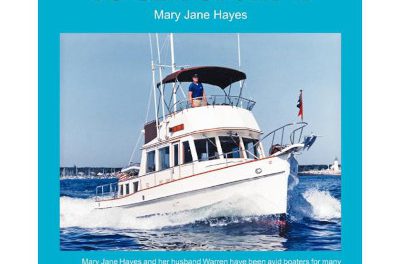For six-time circumnavigator Webb Chiles, small boats are bluewater revelations.
Issue 145: July/Aug 2022
I have owned three great boats, and two of them were small: Chidiock Tichborne, an 18-foot Drascombe Lugger yawl, and Gannet, an ultralight Moore 24 sloop. (The third great boat was Resurgam, a Sparkman and Stevens SHE 36.) I have immense affection for small boats, which, if well-designed, well-built, and well-sailed, can do so much more than most people believe possible.

Webb sails Chidiock Tichborne in Tahiti in 1979.
I made most of my second circumnavigation in Chidiock Tichborne and my sixth, which I finished in April 2019, in Gannet. In both instances, I chose these boats because I wanted a new and different experience of the sea. I did not want to be like some old rock star who is forever singing the songs of his youth. I wanted to sing new songs, and I think that Chidiock Tichborne, Gannet, and I have.
After I completed my first circumnavigation in 1976 in the engineless 37-foot cutter, Egregious, I had very little money and did not know what I would do next. Selling Egregious and publishing my first book, Storm Passage, provided some money, and after a year I sought a new challenge.
I wanted a qualitatively different experience, even simpler, even closer to the sea, with even greater reliance on myself. That the boat would be inexpensive was a given—all of my boats have been.
Before I set out from San Diego in November 1978 in Chidiock, I knew that the design had been
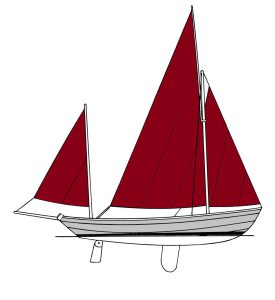
Drascombe Lugger yawl line drawing by Rob Mazza.
tested; David Pyle and Dave Derrick made the first open-boat voyage from England to Australia in the wooden Drascombe Lugger Hermes in 1968. (This journey was described in Pyle’s book Australia the Hard Way.)
I found Chidiock in Anaheim, California, where a park ranger named Rich was selling Luggers part-time using his own as a display model. When I arrived at his place, I found a very pretty boat on a trailer in the driveway. I examined her, found the quality of construction excellent, and asked if I could step on board. Rich said yes. I climbed up and looked around, then lay down. There was just enough room for my shoulders beside the centerboard trunk.
I got up and said, “I’ll buy one.” Rich said, “Great. What are you going to do with her?”
“I’m going to sail her around the world,” I told him. Rich cashed my check quickly.
That was in June. In November, I rowed from the marina in San Diego’s Mission Bay and set out for Nuku Hiva in the Marquesas Islands 3,000 miles away. We made it in 34 days, only a few more than several 40-footers sailing at the same time.
With only 12 inches of freeboard and no deck, Chidiock Tichborne certainly brought me closer to the sea. In fact, one night between Fiji and what is now Vanuatu, she hit something—probably a container—and threw me into the sea. She and I ended up drifting for two weeks and 300 miles before reaching land.
She survived that accident as a bigger boat might not have. Although gunnel-deep in the water, she had sufficient flotation not to sink. I tied her and the inflatable together, and she followed me over the reef onto Emae Island. With new masts, sails, rudder, floorboards, and oars shipped from England, she sailed again five months later and completed 15,000 more miles.
Gannet
My second admirable small boat came into my life when I was living part-time in Evanston, Illinois, a suburb of Chicago on Lake Michigan. The 37-foot IOR one-tonner I had sailed and lived aboard for most of three decades, The Hawke of Tuonela, was based in New Zealand, and I decided to get a second boat to sail on Lake Michigan during the North American summers.
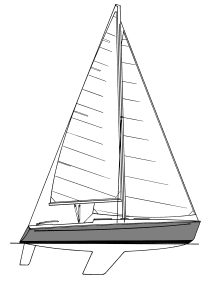
Moore 24 line drawing by Rob Mazza.
Checking boat listings, I came across a Moore 24 for sale in Detroit. I knew of the Moore 24’s superb reputation as the first ultralight class built in the U.S., a 1970s design that continues to win races 50 years later.
I did not want to race, but performance like that was tempting. The Detroit boat sold before I could see her, but the seed had been planted, and I found another Moore for sale in Duluth, Minnesota. I made an offer, and Growler, soon to be renamed Gannet, was mine the following May. Along with changing her name, one of my first modifications was to give away the two old gas outboards and replace them with an electric Torqeedo.
I kept Gannet on Lake Michigan for only two summers. I am pelagic. I like sailing oceans. I need endless horizons. I don’t want to set out one morning and see Michigan appear before sunset. So, I sold Hawke, towed Gannet to San Diego, and decided to sail her around the world. Moore 24s had successfully raced from San Francisco to Hawaii. No one had gone farther than that, but I thought, if 2,000 miles, why not more?
Like all of my boats, Gannet was stock, and I didn’t make huge modifications. I did replace her mast and boom, increasing the rigging by one size—as I have on all of my boats except for Chidiock. It probably was a good decision, since Gannet’s masthead has been in the water at least four times.
Initially I planned to put a self-steering vane on Gannet, but I found that because of her ultralight construction, her transom would have to be strengthened to support a vane at a cost of more than half of what I paid for her. I decided that I could buy a lot of tiller pilots for that amount, and I have. I also knew that I could use sheet-to-tiller self-steering, a method I’ve used to sail more than 50,000 miles on three different boats.
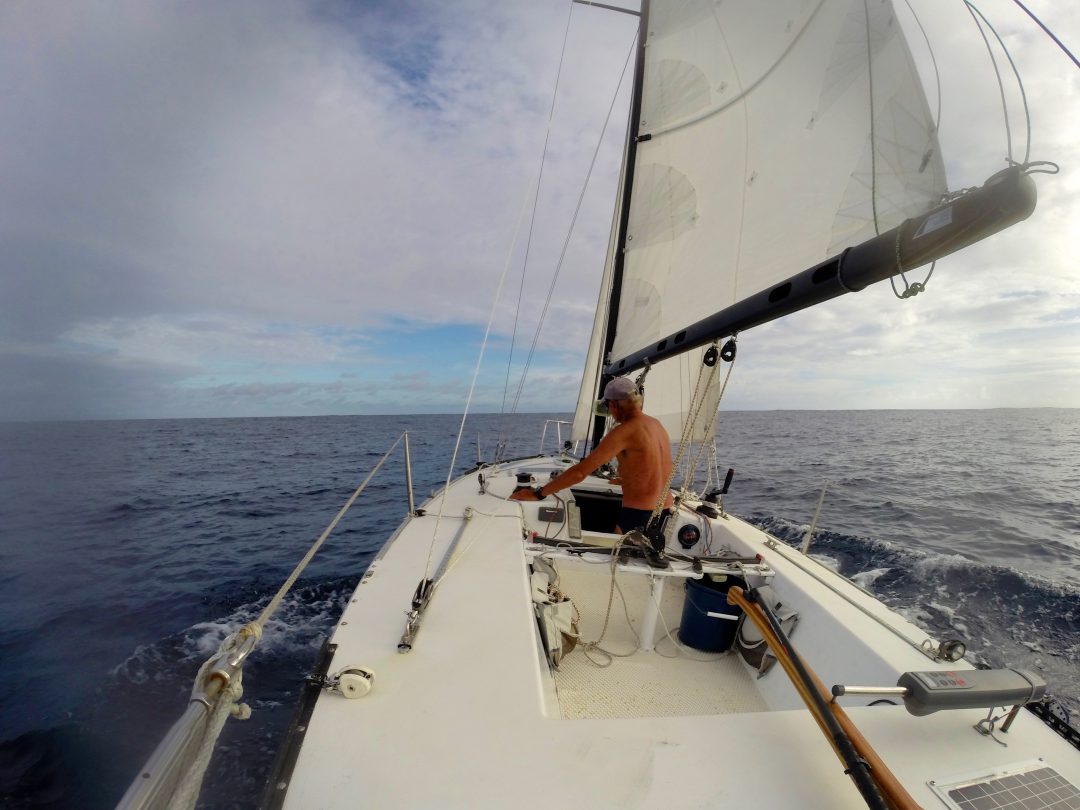
Webb stands in Gannet while the tiller pilot steers.
I carried some equipment on Gannet that I never had on earlier boats: a dry suit, an emergency rudder, and a Jordan drogue. I was glad to have them on board and equally glad never to have needed them.
I navigated on Gannet by iPhone using both iNavX and iSailor charts and apps. I do carry a sextant as backup, and though I made my first two circumnavigations using celestial, I haven’t taken a sight in years.
I do not push Gannet as hard as those who race Moores, but I try to keep her in the groove. She accelerates faster than any other boat I have owned. Going 6 or 7 knots, she catches a wave or a bit more wind and instantly is doing 12 or 14.
Tough Customers
Small, well-built boats are capable of surviving severe weather. Both Chidiock Tichborne and Gannet endured at least two 55-knot gales as recorded by official sources ashore.
With her yawl rig, Chidiock hove to better than any boat I have ever owned by furling the jib, lowering the main, dropping the centerboard three-quarters of the way down, tying the tiller amidships, and flattening the mizzen, all of which weather-cocked the bow into the wind. In Gannet, I lay ahull. Both boats were corks that rose over waves. Mostly.
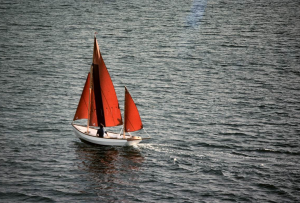
Chidiock Tichborne sailing in 1978, a small boat in big water. Photo by Suzanne Chiles.
Ironically, the most dangerous moments of Gannet’s circumnavigation did not come in gales but on a sunny, moderate-trade-wind day 300 miles from Apia, Samoa. Just after noon, I was standing in the companionway—which on Gannet comes just above my waist—when I saw two 10- to 12-foot waves coming at right angles to the 3- to 4-foot wave pattern.
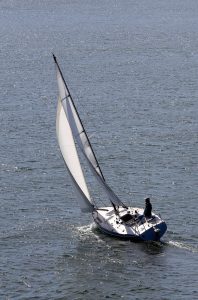
Chiles aboard Gannet sailing out of San Diego’s Quivira Basin in February, 2014. Photo by Steve Earley.
They were steep and close together. As the first one hit, I ducked below, sliding the companionway over me. However, the vertical slat was not in place and not reachable. The second wave exploded into and over us, knocking Gannet down, her masthead touching foaming water.
With the boat heeled 90 degrees, I braced myself from falling and stared down at the ocean. Gannet’s lee rail was underwater, the sea only inches from downflooding the companionway. The wave was gushing in and pressing us down. It was a matter of whether the ocean would reach the companionway before Gannet found her feet. Time slowed to a stop. Probably a few seconds passed. Gannet came back up.
I would not go to sea in just any small boat, or just any big boat either. For me, a boat must be well built, look pretty, have clean, uncluttered lines, and sail well. Notice I didn’t mention comfort. In my experience, no boat is comfortable in a gale—and I have the advantage of not getting seasick. I am glad to be writing this on a comfortable sofa in a sunny room in a condo on Hilton Head Island overlooking the Intracoastal Waterway, but comfort is not a life.
Our lives are as brief as a butterfly’s cough. I believe they are redeemed by moments of joy. I have known countless such moments sailing small boats across oceans.
Webb Chiles, 80, the first American to sail alone around Cape Horn, has circumnavigated six times and married six times. He has no plans to increase either of those numbers. He has been awarded the Cruising Club of America’s Blue Water Medal and the Ocean Cruising Club’s Jester Medal, and he’s published seven books and a multitude of magazine articles about his journeys. He bases Gannet at South Carolina’s Hilton Head Island. You can follow him at inthepresentsea.com/the_actual_site/webbchiles.html and read his online journal at self-portraitinthepresentseajournal.blogspot.com.
Thank you to Sailrite Enterprises, Inc., for providing free access to back issues of Good Old Boat through intellectual property rights. Sailrite.com

